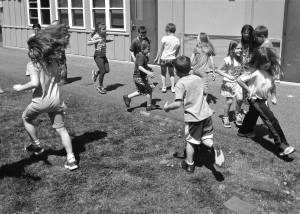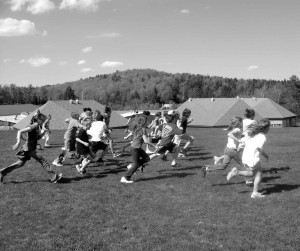Jul 18, 2014 Get Them Moving! Physical Activity Improves Learning.
Excerpt from the Inspired Educator, The Inspired Learner by Jen Stanchfield.
It may be seriously asserted that a chief cause for the remarkable achievements of Greekeducation was that it was never misled by false notions into an attempted separation of mind and body. —John Dewey, 1916, 166
 There is a growing body of evidence demonstrating the positive impact of exercise on brain development and function – and therefore memory and learning throughout life. Exercise has the long-term effect of improving blood flow thereby improving the flow of oxygen and nutrients to the brain. Neuroscientists have found exercise also increases blood flow in certain regions of the brain such as the hippocampus—an area of the brain that plays an important role in the organization of memory and the transfer of information from short term memory to long-term memory (Chapman et al., 2013). Researchers have found that exercise increases the survival of newly formed brain cells in the hippocampus of lab animals and both young and older adults. It also causes the release of growth factors that support the development of dendrites and synapses and synaptic plasticity in the brain –the ability of the brain to change (Aamodt & Wang, 2011). “Physical exercise may be one of the most beneficial and cost effective therapies widely available to everyone to elevate memory performance” (Chapman, 2013).
There is a growing body of evidence demonstrating the positive impact of exercise on brain development and function – and therefore memory and learning throughout life. Exercise has the long-term effect of improving blood flow thereby improving the flow of oxygen and nutrients to the brain. Neuroscientists have found exercise also increases blood flow in certain regions of the brain such as the hippocampus—an area of the brain that plays an important role in the organization of memory and the transfer of information from short term memory to long-term memory (Chapman et al., 2013). Researchers have found that exercise increases the survival of newly formed brain cells in the hippocampus of lab animals and both young and older adults. It also causes the release of growth factors that support the development of dendrites and synapses and synaptic plasticity in the brain –the ability of the brain to change (Aamodt & Wang, 2011). “Physical exercise may be one of the most beneficial and cost effective therapies widely available to everyone to elevate memory performance” (Chapman, 2013).
Antronette Yancy (Toni) was known as a luminary in the public health field and regularly addressed the importance of physical activity to promote learning and work success for people of all ages. Yancy was a professor in the Department of Health Services, UCLA School of Public Health, and author of Instant Recess: How to Build a Fit Nation 10 Minutes at a Time (2010). In a 2006 radio interview on National Public Radio’s Morning Edition, she stated, “Kids pay better attention to their subjects when they’ve been active. Kids are less likely to be disruptive in terms of their classroom behavior when they’re active. Kids feel better about themselves, have higher self-esteem, less depression, less anxiety—all of those things can impair academic performance and attentiveness.” In her interview she described a study of elementary students sharing that groups who exercised every day performed best in the classroom and that though time was taken away from academic subjects for physical education, across the board that did not hurt the student’s performance on the academic tests. And in fact, in the condition in which the trained teachers provided the physical education, the children actually did better on language, reading, and the basic battery of tests (Neighmond, 2006).
An exciting new study by researchers at Stanford University has demonstrated the positive impact of walking on creative output. In the study published in the Journal of Experimental Psychology, researchers used the Guilford’s Alternative Uses test to measure creative thinking. Students who took the test after walking on a treadmill and outside on campus improved their average by 60 percent—and it remained high for an extended time after sitting down post-exercise (Oppezzo & Schwartz, 2014, cited by Bartlett, 2014). In the fourth experiment on creative analogy generation, walking outside produced the most novel and highest quality analogies (Oppezzo & Schwartz).
John Dewey stated 120 years ago in his My Pedagogic Creed:
I believe that the active side precedes the passive in the development of the child nature; that expression comes before conscious impression; that the muscular development precedes the sensory; that movements come before conscious sensations; I believe that consciousness is essentially motor or impulsive; that conscious states tend to project themselves in action.
I believe that the neglect of this principle is the cause of a large part of the waste of time and strength in school work. The child is thrown into a passive, receptive, or absorbing attitude. The conditions are such that he is not permitted to follow the law of his nature; the result is friction and waste (McDermott, 1981, p. 450-451).
John Ratey (2008), an associate clinical professor of psychiatry at Harvard and the author of Spark, shared research that emphasized how exercise enhances learning, lowers stress and anxiety, and increases cognitive performance. His book includes chapters on the beneficial effects of exercise on stress, anxiety, depression, attention deficit, addiction, hormonal changes and aging. In children, aerobic fitness is correlated with math and reading achievement, IQ, verbal ability, mathematical ability, academic readiness, self-control, and memory tasks.
This evidence makes a strong argument for physical education and recess in schools and for fitness programs in the workplace. In an era of cutbacks in schools of what are regarded by some as “specials” or “extras” like physical education, we are not only doing a disservice to our students’ physical health and social skills development, but we are missing an important opportunity to increase and maintain cognitive function in the classroom and workplace.
 This information on the importance of movement aligned with learning has implications for day-to-day practices in the classroom or boardroom. Consider seating arrangements planning breaks in direct instruction for movement, integrating movement into lessons, as well as supporting physical education in schools and fitness in the workplace. Balancing sedentary lecture time with active engagement and movement activities improves learning.
This information on the importance of movement aligned with learning has implications for day-to-day practices in the classroom or boardroom. Consider seating arrangements planning breaks in direct instruction for movement, integrating movement into lessons, as well as supporting physical education in schools and fitness in the workplace. Balancing sedentary lecture time with active engagement and movement activities improves learning.
Exercise is the single most powerful tool you have to optimize your brain function. — John Ratey
References:
Bartlett,Tom (2014)A Walk in the Park. The Chronicle of Higher Education Blog May 7th, 2014. Retrieved from: http://chronicle.com/blogs/percolator/a-walk-in-the-park/34233
Chapman SB, Aslan S, Spence JS, DeFina LF, Keebler MW, Didehbani N and Lu H (2013) Shorter term aerobic exercise improves brain, cognition, and cardiovascular fitness in aging. Frontiers in Aging Neuroscience. 5:75. Retrieved fromhttp://journal.frontiersin.org/Journal/10.3389/fnagi.2013.00075/abstract
Chapman, Sandra, B. Center for Brain Healthy Blog: Aerobic Exercies Improves Memory, Brain Function and Physical Fitness November 12th, 2013. Retrieved from http://www.brainhealth.utdallas.edu/blog_page/study-finds-aerobic-exercise-improves-memory-brain-function-and-physical-fitness June, 2014
McDermott, J. (1981) The philosophy of John Dewey (two volumes in one): 1. The structured experience; 2. The lived experience. Chicago: University of Chicago Press.
Wang, Sam & Aamodt, Sandra. (2011) Welcome to Your Child’s Brain. Bloomsbury Publishing. Their website also has great resources:http://www.welcometoyourbrain.com/
Neighmond, P. (Health Policy Correspondent). (August 31, 2006,). Exercise helps students in the classroom [Radio series episode]. In Morning Edition. Boston: NPR.
Oppezzo, M., & Schwartz, D. L. (2014, April 21). Give Your Ideas Some Legs: The Positive
Effect of Walking on Creative Thinking. Journal of Experimental Psychology: Learning, Memory, and Cognition. Advance online publication. http://dx.doi.org/10.1037/a003657
Ratey, J. J., & Hagerman, E. (2008). Spark: the revolutionary new science of exercise and the brain. New York: Little, Brown.
Yancey, A. K. (2010). Instant recess building a fit nation 10 minutes at a time. Berkeley: University of California Press.



Why Swing for Kids is so Important - Swing for Kids
Posted at 09:06h, 26 December[…] There is a growing body of evidence demonstrating the positive impact of exercise on brain development and function – and therefore memory and learning throughout life. Exercise has the long-term effect of improving blood flow thereby improving the flow of oxygen and nutrients to the brain. – The Inspired Educator […]